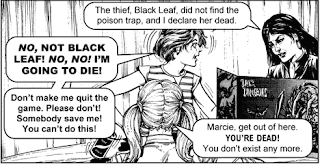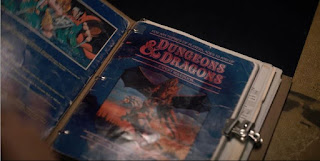Here's a story from my gaming youth.
When I was young, my mom, influenced by the Satanic Panic of the 1980s, forbade me from playing D&D. Thus, while I had been introduced to the game years before by watching my brother play, I actually cut my RPG teeth on Top Secret and I.C.E.'s Middle Earth Roleplaying Game.
The guy who sort of reintroduced me to the original RPG or, rather, the Second Edition of the Advanced version of the original RPG, was my cousin. I spent a couple of long weekends at his house in Minnesota one summer, and he showed my all his kick-ass AD&D books. My favorites were the Monstrous Compendiums, these huge white binders full of loose-leaf monsters. Something about these badies grabbed my imagination, particularly their often lengthy ecology entries. Looking back on it now, these writeups were often a combination of too serious and too stupid to be very useful at the gaming table, but to my young eyes they just made these fantastic creatures seem so real.
As is often the case when you're 12 years old, learning something from another 12 year-old, you don't always get all the details correct. A lot of us have stories about rules that we radically misinterpreted during our formative years of gaming. For me, learning from my cousin, the problems were not with the rules but with the mispronunciation of words.
One good example, and the point of this post, was the way that my cousin pronounced one of his favorite monsters: the ogre.
For some reason, we both got it in our heads that this word was pronounced as though it was spelled o-r-g. As in orc, only with a g instead of a c at the end. This stuck with me for an entire summer at least, until someone finally grew exasperated enough to point out that the word was oge-er.
I was telling this story to my kids the other night when it occurred to me that I should really sit down and stat out a monster called an org, just to kind of complete the circle. I've always thought that D&D could use some kind of beastman, not unlike the monsters from the Warhammer Fantasy setting. You know, monstrous half-man half-animal humanoids that variously resemble goats, rams, and other beasties. Beastman is not a very evocative name, however, so why not call them orrgs?
Sure, I'd never make a monster called an orrg were it not for my cousin's mistake all those years ago. For one, the name sounds way too much like orc. It's a little bit stupid, not unlike a lot of those AD&D monster ecologies from back in 2E. On the other hand, that stupidity is rather charming, and it's important not to take D&D too seriously, right? So, in that vein, I present you with...the orrg, statted for Swords & Wizardry. I'm spelling it with a double rr, lest people think that I'm simply making a typo every time I try to type orc.
Free stock art courtesy of 1manstudio.

 |
| My mom was a big fan of Blackleaf. |
The guy who sort of reintroduced me to the original RPG or, rather, the Second Edition of the Advanced version of the original RPG, was my cousin. I spent a couple of long weekends at his house in Minnesota one summer, and he showed my all his kick-ass AD&D books. My favorites were the Monstrous Compendiums, these huge white binders full of loose-leaf monsters. Something about these badies grabbed my imagination, particularly their often lengthy ecology entries. Looking back on it now, these writeups were often a combination of too serious and too stupid to be very useful at the gaming table, but to my young eyes they just made these fantastic creatures seem so real.
As is often the case when you're 12 years old, learning something from another 12 year-old, you don't always get all the details correct. A lot of us have stories about rules that we radically misinterpreted during our formative years of gaming. For me, learning from my cousin, the problems were not with the rules but with the mispronunciation of words.
One good example, and the point of this post, was the way that my cousin pronounced one of his favorite monsters: the ogre.
For some reason, we both got it in our heads that this word was pronounced as though it was spelled o-r-g. As in orc, only with a g instead of a c at the end. This stuck with me for an entire summer at least, until someone finally grew exasperated enough to point out that the word was oge-er.
I was telling this story to my kids the other night when it occurred to me that I should really sit down and stat out a monster called an org, just to kind of complete the circle. I've always thought that D&D could use some kind of beastman, not unlike the monsters from the Warhammer Fantasy setting. You know, monstrous half-man half-animal humanoids that variously resemble goats, rams, and other beasties. Beastman is not a very evocative name, however, so why not call them orrgs?
Sure, I'd never make a monster called an orrg were it not for my cousin's mistake all those years ago. For one, the name sounds way too much like orc. It's a little bit stupid, not unlike a lot of those AD&D monster ecologies from back in 2E. On the other hand, that stupidity is rather charming, and it's important not to take D&D too seriously, right? So, in that vein, I present you with...the orrg, statted for Swords & Wizardry. I'm spelling it with a double rr, lest people think that I'm simply making a typo every time I try to type orc.
Free stock art courtesy of 1manstudio.

ORRG
Hit Dice: 1
Armor Class: 8 [11]
Attacks: Weapon or natural weapon
Saving Throw: 17
Special: Fury
Move: 12
Alignment: Chaos
Challenge Level/XP: 2/30
Orrgs are savage humanoids that resemble a cross between men
and beasts. Orrgs are broad-shouldered, muscular, and covered with thick, curly
hair. Their flat faces resemble that of a sheep or goat, as do their legs and cloven
hooves, but they are otherwise human from the waist up. Most but not all orrgs
have horns, usually broad and curled like a ram’s, although some have short
straight horns and a few sport deer-like antlers. Creatures of almost pure
chaos, the orrgs are a universally violent, bloodthirsty race. They fight to the
death, adding a +2 to all attack rolls because of their great fury.
Rumors exist of orrgs who possess far different
characteristics than the rest of their race, with bony-plated skin, bear-like
muzzles, or serpentine appendages. Whether these mutants are the chosen
warriors of the orrg’s chaos-gods, some rare off-shoot of the main race, or
merely the bugaboo of some adventurer’s tall tale is as of yet unknown.











